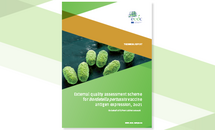External quality assessment scheme for Bordetella pertussis vaccine antigen expression, 2021
This report presents the results of the first external quality assessment (EQA) scheme for Bordetella pertussis vaccine antigen expression, pertactin (PRN), pertussis toxin (PT) and filamentous haemagglutinin (FHA) by the European Centre for Disease Prevention and Control (ECDC) as part of the European Reference Laboratory Network for Pertussis (ERLNPert-Net) activities.
Executive summary
- Antigen expression testing of B. pertussis isolates is not routinely performed by all Member State reference laboratories. As part of the ERLNPert-Net activities, capacity-building and training was provided to 13 Member States[1], while a total of 15 Member States were considered to have experience in this technique.
- The EQA was conducted during 2021 and only 12 laboratories from 12 EU/EEA countries participated in the scheme. This was due to a combination of factors, including the active involvement of many laboratories and personnel with their response to COVD-19 pandemic. Of the 12 Member States that participated in this EQA, eight performed at least one of the antigen expression components. Of these eight, seven had prior experience of the technique.
- The test panel included eight strains of B. pertussis together with three control strains. The panel included B. pertussis strains belonging to the serotypes/fimbrial serotypes 1,0,0 (FIM- [minus]); 1,2 (FIM2); 1,3 (FIM3) and 1,2,3 (FIM2,3) together with those expressing and not expressing pertactin (PRN+/-), pertussis toxin (PT+/-) and filamentous haemagglutinin (FHA+/-).
- The EQA scheme was divided into three sections: (1) Fimbrial serotyping: to assess the ability of each laboratory to correctly report the expression/non-expression of fimbriae in the panel and report the fimbrial serotype for each strain; (2) pertactin/pertussis toxin expression: to assess the ability of each laboratory to correctly report the expression/non-expression status of pertactin/pertussis toxin for each strain and (3) filamentous haemagglutinin expression (optional): to assess the ability of each laboratory to correctly report the expression/non-expression status of FHA for each strain.
- For serotyping, the two reagents recommended were the WHO International Standard monoclonal antibody for serotyping B. pertussis fimbrial antigen 2 (1st WHO International Standard), National Institute for Biological Standards and Control (NIBSC) code: 06/124, and WHO International Standard monoclonal antibody for serotyping B. pertussis fimbrial antigen 3 (1st WHO IS) NIBSC code: 06/128. For vaccine antigen (PRN, PT, FHA) expression, the following reagents were recommended: PeM4 monoclonal antibody, which targets the pertactin (PRN) region 1 (from National Institute for Public Health and the Environment, Ministry of Health, Welfare and Sport in the Netherlands (RIVM), supplied by the UK Health Security Agency (UK HSA) for this EQA scheme on request); non-WHO reference material anti-PT S1 subunit monoclonal antibody 10D6 NIBSC code: 99/512; non-WHO reference material anti-PT S3 subunit monoclonal antibody 7E10 NIBSC code: 99/542 and non-WHO reference material anti-filamentous haemagglutinin monoclonal antibody 2E9 NIBSC code: 99/572 (available from National Institute of Biological Standards and Control (NIBSC), UK).
- Only 2 of 11 (18%) laboratories scored 8/8 (100%, intended results) in section (1) fimbrial serotyping, compared to 7/14 (50%) in a previous fimbrial serotyping EQA which comprised four strains [1]. In this EQA all 11 laboratories used monoclonal antibodies (mAbs). Ten of 11 used 06/124 mAb Fim2 and 06/128 mAb Fim3 from NIBSC and one used in-house mAbs. Analysis was performed by ELISA for 5/10 and slide agglutination by 6/10 laboratories. Explanations for the low overall scores for fimbrial serotyping in this EQA include potential variation in phenotypic expression due to delay in transport and differing pre-test culture conditions; autoagglutination; differences in experience of operators in technique used; lack of availability of additional control material and differences in interpretation and cut-offs used for the ELISA.
- Eight of 10 (80%) laboratories scored 8/8 (100%, intended results) in section (2) for the ability to distinguish PRN expression/non-expression in B. pertussis. Most laboratories (7/10) used the recommended ELISA protocol, with five using the PeM4 pertactin mAbs, two using the non-WHO reference material B. pertussis polyclonal anti-69kD serum 97/558 (NIBSC) and one using in-house pertactin polyclonal antibodies and Western blot.
- Four of seven (57%) laboratories scored 8/8 (100%, intended results) in section (2) for the ability to distinguish PT expression/non-expression; three of these laboratories used the recommended ELISA protocol with the anti-pertussis toxin monoclonal antibodies 99/512 (S1) and 99/542 (S3) (NIBSC) and one used Western blot with an in-house polyclonal pertussis toxin antibody.
- Six of seven (86%) laboratories scored 100%, in section (3) for the ability to distinguish FHA expression/nonexpression, four using the recommended ELISA protocol with the non-WHO reference material antifilamentous haemagglutinin monoclonal antibody 2E9 (99/572, NIBSC), one using Western blot with an inhouse polyclonal FHA antibody and two using whole genome sequencing (WGS) to predict FHA expression.
- Three laboratories used analyses from WGS to predict expression of PRN, PT and/or FHA. One laboratory did not submit results for the PRN expression as these methodologies were not available. One of the other two laboratories correctly predicted PRN expression/non-expression by identifying the presence of silent mutations or premature stops/insertions within the coding region, respectively. Only one laboratory performed PT prediction and incorrectly predicted expression for the PT- strain (EQA06), scoring 7/8. Only one of two laboratories performing FHA prediction correctly predicted FHA expression/non-expression for the FHA- strain (EQA07), scoring 8/8.
- Results for the first EQA on vaccine antigen (PRN, PT, FHA) expression were encouraging, especially for pertactin which was the priority target due to the rise in circulating PRN non-expressing strains.
- Overall, WGS performed by three countries and its analysis was successful in identifying known mutations and previously described reasons for non-expression, but in some cases it incorrectly predicted the phenotype.
- Pertussis National Reference Laboratories (NRLs) should be able to correctly perform fimbrial serotyping and vaccine antigen expression assays for surveillance of circulating B. pertussis isolates.
- This EQA identified training needs in fimbrial serotyping and the detection of vaccine antigen expression to help achieve the above.
[1] The UK also participated in training as it was an EU Member State at the time.





